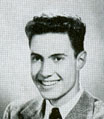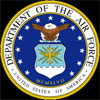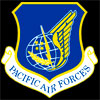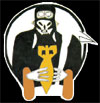| Edwin Arthur McDaniel |
 |
| Year |
|
Rank |
|
Status |
 |
| June, 1948 |
|
Graduated |
|
Graduated from North High
School, Des Moines, IA. |
| Fall, 1948 |
x |
Enlisted/US
Air Force |
x |
Recruiting Office at KRNT
Theater. |
| date |
x |
Basic Training |
x |
*Sheppard Air Force Base,
Wichita Falls, TX. |
| date |
x |
Training |
x |
**Lowry Air Force Base,
Denver, CO. |
| date |
x |
Training |
x |
Hamilton Air Force Base
north of San Francisco, CA for training in multi-engines. |
| Fall, 1949 |
x |
Duty |
x |
***Eielson Air Force Base,
AK north of Fairbanks, AK. RB-50 Reconnaissance. 375th Bombardment
Squadron. 18 months. |
| date |
x |
Duty |
x |
Tokyo, Japan |
| Fall, 1952 |
x |
US Air Force/
Discharged/Sgt. |
x |
Discharged at Reese Air
Force Base, Lubbock, TX |
Fall, 1952-
Jan.,1990 |
x |
Employed |
x |
Northwestern Bell. Then
US West. Then Qwest. While at US West, retired as Director of
Outside Plant Operations for the state of Iowa |
| 1990-Present |
x |
Retired |
x |
Retired and living in
IA. |
|
*Sheppard AFB,
Wichita Falls, TX
Air Education and Training Command
Sheppard Air Force Base (IATA: SPS, ICAO: KSPS, FAA LID: SPS) is a United
States Air Force base located five miles (8 km) north of the central
business district of Wichita Falls, in Wichita County, Texas, United
States.[2] It is the largest training base and most diversified in Air
Education and Training Command. Comptroller, transportation, and intelligence
training moved to Sheppard from Lowry AFB, Colorado, in the fall of
1954.
**Lowry Air Force Base, Denver, CO
Air Training Command
Lowry Air Force Base (1938?1994) is a former United States Air Force
base located in the cities of Aurora and Denver, Colorado. Its primary
mission throughout its existence was Air Force technical training
and was heavily involved with the training of United States Army Air
Forces bomber crews during World War II. It was also the home of the
United States Air Force Academy from 1954 to 1958, until the Academy's
permanent site in Colorado Springs was completed.
With the beginning of the Korean War, Lowry Air Force
Base expanded its training program. Courses taught, in addition to
photography and armament, included rocket propulsion, missile guidance,
electronics, radar-operated fire-control systems, computer specialties,
gun and rocket sights, and electronically operated turret systems.
***US Air Force; 375th Bombardment Squadron
Activated in early 1942 in Idaho as a long-range
B-24 Liberator bombardment squadron under Second Air Force. For the
next three months little training occurred while the unit worked through
its growing pains, resolving administrative and personnel acquisition
difficulties. Then a totally new problem arose....all but four personnel
were transferred to the 330th Bombardment Group! While active on paper,
it wasn't until September that personnel were taken from the 39th
Bombardment Group to form a headquarters cadre for the 308th Group,
again making it a viable unit. On 29 September the squadron was designated
an Operational Training Unit (OTU) with Wendover Field, Utah as its
home station. The unit was fully manned by November, after receiving
personnel from the 18th Replacement Wing.
Reactivated in Alaska in 1947 as a Strategic Air Command weather reconnaissance
squadron. Gathering weather information for combat readiness was an
integrated part of strategic aerial reconnaissance. Weather recon,
though, was a particularly loose term. There was a constant need for
weather information, but weather flights were also a convenient cover
for the more covert missions with RB-29 Superfortress photo-reconnaissance
aircraft over the eastern frontier of the Soviet Union. Inactivated
in February 1951.
Reactivated a few months later in October with
new B-47E Stratojet swept-wing medium bombers, capable of flying at
high subsonic speeds and primarily designed for penetrating the airspace
of the Soviet Union. In the early late 1950s, the B-47 was considered
to be reaching obsolescence, and was being phased out of SAC's strategic
arsenal. B-47s began being sent to AMARC at Davis-Monthan in July
1959 and the squadron went non-operational. Was inactivated on 25
June 1961.
Eielson Air Force Base (AFB) (IATA: EIL, ICAO: PAEI, FAA LID:
EIL) is a United States Air Force base located approximately 26 miles
(42 km) southeast of Fairbanks, Alaska and just southeast of Moose
Creek, Alaska. The host unit at Eielson is the 354th Fighter Wing
(354 FW) assigned to the Pacific Air Forces Eleventh Air Force. The
354 FW primary mission is to support Red Flag – Alaska, a series of
Pacific Air Forces commander-directed field training exercises for
U.S. Forces, provides joint offensive counter-air, interdiction, close-air
support, and large force employment training in a simulated combat
environment. Eielson AFB was established in 1943 as Mile 26 Satellite
Field. It is named in honor of polar pilot Carl Ben Eielson. The 354
FW is currently commanded by General James N. Post III. The 354th
was at Ladd Air Force Base.
On 1 December 1947 Strategic Air Command B-29 Superfortress bombers
arrived at 26-Mile Airfield with the deployment of the 97th Bombardment
Wing, Very Heavy, from Smoky Hill AFB, Kansas. The wing reported to
Fifteenth Air Force, Strategic Air Command (SAC), although the Yukon
Sector of the Alaskan Air Command controlled its operations. At the
end of the Alaskan deployment the wing returned to Kansas on 12 March
1948. A year later, however, Eielson moved from under the shadow of
Ladd Field when the Alaskan Air Command assumed organizational control.
Also in the fall of 1947, Colonel Jerome B. McCauley assumed duties
as commander. The primary missions of Mile 26 were to support Arctic
training for USAF tactical and strategic units, as well as defend
the base itself. Headquarters USAF General Order 2, dated January
13, 1948, redesignated Mile 26 as Eielson AFB. It was named for Carl
Ben Eielson, an Alaska aviation pioneer who was killed, along with
his mechanic Earl Borland, in the crash of their Hamilton aircraft
in 1929. Eielson and Borland were attempting a rescue flight to an
icebound ship in the Bering Sea when they were killed. On April 1,
1948, the Eielson AFB Wing (Base Complement) was formed. The host-unit
subsequently would be dubbed the Eielson AFB Bomb Wing, and finally,
in January 1949, the 5010th Wing. Colonel John L. Nedwed, the third
commander of the base since it fell under Alaskan Air Command fifteen
months before, became the first to head the 5010th.
|



